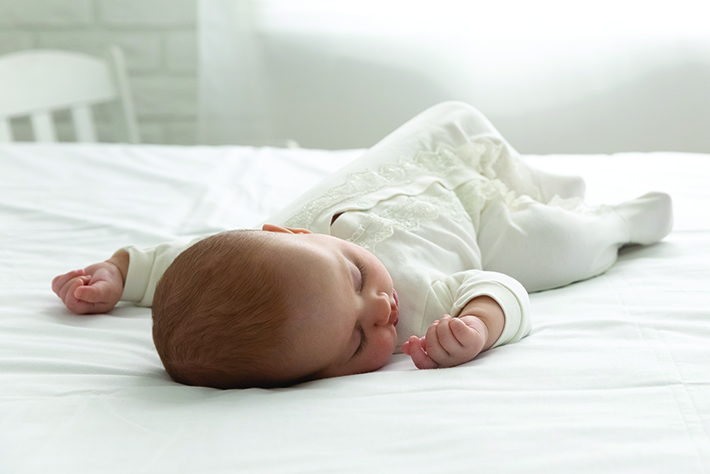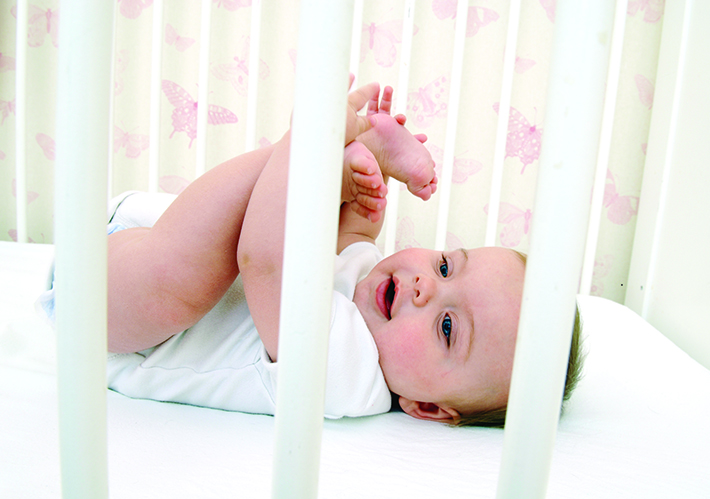
Standards to Create Safer, More Breathable Juvenile Products
Parents and caregivers bear a tremendous responsibility for keeping infants healthy and safe. Yet, sometimes, in spite of best efforts, accidents occur. The Centers for Disease Control (CDC) reports that in 2022, roughly 3,700 children in the U.S. died from unexpected events such as accidental suffocation and strangulation in bed (ASSB) and sudden infant death syndrome (SIDS). Defined as the abrupt and unexplained death of a child under two, SIDS claimed 1,518 lives in 2022.
SIDS often occurs during sleep and has no specific cause, but research has shown that some sleep factors may increase its likelihood. In SIDS and ASSB especially, impaired breathing plays a major role. Soft bedding can press against an infant’s nose and mouth, restricting airflow. Because an infant cannot easily lift its head and move out of this position or push away the bedding, the chance of suffocation increases.
To reduce this risk, in the fall of 2024, ASTM International’s committee on consumer products (F15) introduced a subcommittee dedicated to the firmness and breathability of juvenile products (F15.12). The group originated in the subcommittee on infant bedding (F15.19), from the recognition that the testing and support of infant products, such as bedding, nursing pillows, and support cushions, were distinctive enough to warrant their own subcommittee.
Juvenile merchandise may be marketed as breathable. But this can lead to confusion because breathability means different things to different people, says Michael E. Leshner, professional engineer, technical contact for F15.12, and past president of the National Academy of Forensic Engineers. “We have to find a way to measure something that has no specific definition,” he says.
People’s definitions of breathability may differ, but most agree that rebreathing is a serious threat to sleeping infants. A presumed factor in SIDS, rebreathing occurs when an infant breathes in his or her own exhaled air, taking in more carbon dioxide than oxygen. If rebreathing is not interrupted, the oxygen level will drop while the carbon dioxide level rises, ultimately resulting in death. This may happen when an infant sleeps face-down on a pillow or mattress or even on its back with its nose and mouth obstructed by bedding, a stuffed animal, or other soft item.
“There are too many fatalities associated with infants getting their face into soft bedding where they can’t breathe. They can suffocate due to lack of oxygen or from rebreathing their own CO2,” says Don Mays, chair of F15. “It’s hard to prove what the cause is after death.”
Breathability standards for infants differ from other safety standards in terms of their emotional impact, Leshner says. Along with manufacturers, federal government regulators, testing labs, and safety advocates, the subcommittee is working with parents who have lost infants to suffocation or strangulation during sleeping. “This is special because it’s life and death,” he says.
Firmness, Resistance, and Rebreathing
To help determine the breathability and firmness of juvenile products, three new work items have been registered within the infant bedding subcommittee (F15.12). These are the new test method for airflow resistance of infant products (WK84613); the test method for firmness of infant products (WK84614); and the test method for the measurement of rebreathing in infant bedding materials (WK84615).
Airflow resistance refers to how easily exhaled air can travel through a product. Something with low or zero airflow resistance allows air to pass through it, making that product more breathable. The airflow resistance test method (WK84613) would help quantify breathability and what is breathable. It will not include performance specifications.
FOR YOU: ASTM Standards Usher in New Era of Crib Safety
A common assumption is that soft bedding provides a safe, cozy sleeping environment for infants, but this is not always true. Even when parents follow the guidance of pediatricians and health and safety organizations and place babies on their backs for sleeping, fatalities related to soft bedding can occur. The CDC, U.S. Consumer Protection Safety Commission (CPSC), and American Academy of Pediatrics all advise placing an infant on a firm, tight-fitting mattress without bedding (pillows, quilts, comforters, and blankets and soft, stuffed toys) in the crib. If the room feels chilly, parents should dress the infant in footed pajamas.
 Safer products mean safer babies.
Safer products mean safer babies.
ASTM’s firmness test method (WK84614) would establish a firmness test for infant products that are not flat in shape, such as infant support pillows. The aim is to prevent infants from placing their faces deep into a soft object and obstructing their airflow. A firm sleeping surface can be a defense against airflow resistance and breathing in CO2-rich, exhaled air.
Of the three work items, firmness is the first test method being addressed. Because crib mattresses already have their own test method in the standard consumer safety specification for crib mattresses (F2933) from the subcommittee on crib mattresses (F15.66), they would not be part of this new standard.
The test method for measuring rebreathing in infant bedding materials (WK84615) would enable manufacturers to identify all material and potential construction hazards in their juvenile merchandise. The test method would utilize a mechanical breathing model, carbon dioxide gas, and a carbon dioxide analyzer.
“You can’t tell by looking at or touching a product whether it’s hazardous. You have to measure it,” says Leshner, who has designed some of the testing equipment. “We’re measuring three hazards with three different test methods and providing the tools for product designers to screen their designs as they’re developing them and design products that meet certain safety standards.”
He adds that creating these test methods is a highly technical process, and the subcommittee would love to have more subject matter experts — engineers and doctors, particularly pediatricians and pulmonologists — participate in this valuable work.
Beyond Bedding
Because there is no guarantee that an infant won’t drift off to sleep in something not meant for sleeping, the new test methods would apply to a range of juvenile products, including infant loungers and bouncers. These, as well as other seated items such as rockers, swings, and strollers, are also being evaluated by the CPSC. The goal is to design products that keep babies safe even if the products are not used as intended.
“The CPSC has been looking at softer infant products that can potentially be used for sleep and either setting standards to change the way the manufacturers make those products or banning the products altogether,” Mays says.
Nursing pillows are one of the products impacted by these efforts. The CPSC defines nursing pillows as “any product intended, marketed, or designed to position and support an infant close to a caregiver’s body while breastfeeding or bottle feeding.” Although these pillows are indicated for nursing only and labeled and marketed as such, infants do occasionally nod off during or after feeding, while still on these pillows.
The CPSC notes that, between 2010 and 2022, 154 U.S. infant fatalities and 64 injuries occurred as a result of nursing pillows being used for sleeping. Of those deaths, nearly all resulted from asphyxia, suffocation, sudden unexpected infant death (SUID), or SIDS.
In September 2024, the subcommittee on nursing pillows (F15.16) published the standard consumer safety specification for nursing pillows (F3669). Among its safety performance requirements is that, to minimize hazards to infants, nursing pillows should have a firmness of greater than 10 newtons (roughly 2.25 pounds) per inch of force. Anything softer could allow a baby’s face to conform to the pillow’s surface and impair its breathing.
READ MORE: The CPSC and ASTM Collaboration
“The subcommittee developed the performance requirements for the safety standard for nursing pillows based on the CPSC-commissioned Boise State University study, ‘Pillows Product Characterization and Testing.’ The study emphasized the importance of firmness as the primary safety measure and airflow as a secondary safety measure,” says Jessica Doyle, chair of subcommittee F15.16. “For practicality and design reasons, in ASTM’s nursing pillow standard, if the product passes the firmness test, the airflow test is not required.”
The subcommittee on breathability and firmness of juvenile products is likewise referencing the Boise State study. Funded by the CPSC, the study analyzed the risk of injury or death to infants from infant support cushions and nursing pillows. The work was led by Dr. Erin Mannen, Boise State associate professor of mechanical and biomedical engineering and director of the Boise Applied Biomechanics of Infants Laboratory. Among her team’s findings were that products lacking firmness were more likely to cover or block an infant’s nose and mouth, causing a suffocation hazard, and that a firm product was less likely to seal off an infant’s airways.
Complications and Considerations
It comes as no surprise that, with a subject as complex and wide-ranging as the firmness and breathability of products for infants, complications and considerations will arise.
“There are broad implications to these requirements being applied unilaterally to various product categories because each product is unique and has different characteristics – and different ways that the child can occupy the space and interact with the product,” Lisa Trofe says. She is the executive director of the Juvenile Product Manufacturers Association and chair of the infant bedding subcommittee. “We need to be very conscious of how we apply these firmness and breathability standards to the products.”
Trofe adds that handheld infant carriers (F2050), which double as car seats, have a slightly different scope than other infant products. When used as car seats, handheld infant carriers are regulated by the National Highway Traffic Safety Administration (NHTSA).
“The foam and materials used in the carriers are meant to supply crash protection in the event of a car accident,” Trofe says. “Mitigating those for any type of use outside of the car is concerning if they could potentially impact the safety of a child when the carrier is used inside the vehicle.”
Along with considerations about how a change in materials could impact a product’s performance, there are concerns around testing and cost. According to Leshner, the cost for a lab to test for CO2 rebreathing is $16,000 per test. At this price, major manufacturers can afford to have their products tested but smaller companies often cannot. One of Leshner’s objectives for the subcommittee is to produce testing equipment that can carry out these tests at a reasonable cost.
There are also the test results themselves. A product may get high marks for firmness but end up having poor airflow, causing a risk of rebreathing high levels of carbon dioxide, Mays says.
“Understanding the hazards is difficult,” Leshner says. “Some think it’s mechanical obstructions. Some think it’s exhaled breath that’s the problem. It’s more complex than that. Two different hazards may happen at the same time and you need to address both.”
Through the efforts of the subcommittee on firmness and breathability of juvenile products, companies will be able to manage those hazards and others. The goal of these and future standards is to reduce, if not eliminate, potential hazards, injuries, and fatalities and enable manufacturers to design safer juvenile products.
“Even when we get to down to a certain number of fatalities, it’s still not acceptable,” Leshner says. “There will not be an end to finding hazards and understanding how to prevent them.”
For additional information or to join the subcommittee on firmness and breathability of juvenile products (F15.12), please contact staff manager Molly Lynyak at mlynyak@astm.org. ●
Kathy Hunt is a U.S. East Coast-based journalist.
 SN Home
SN Home Archive
Archive Advertisers
Advertisers Masthead
Masthead RateCard
RateCard Subscribe
Subscribe Email Editor
Email Editor